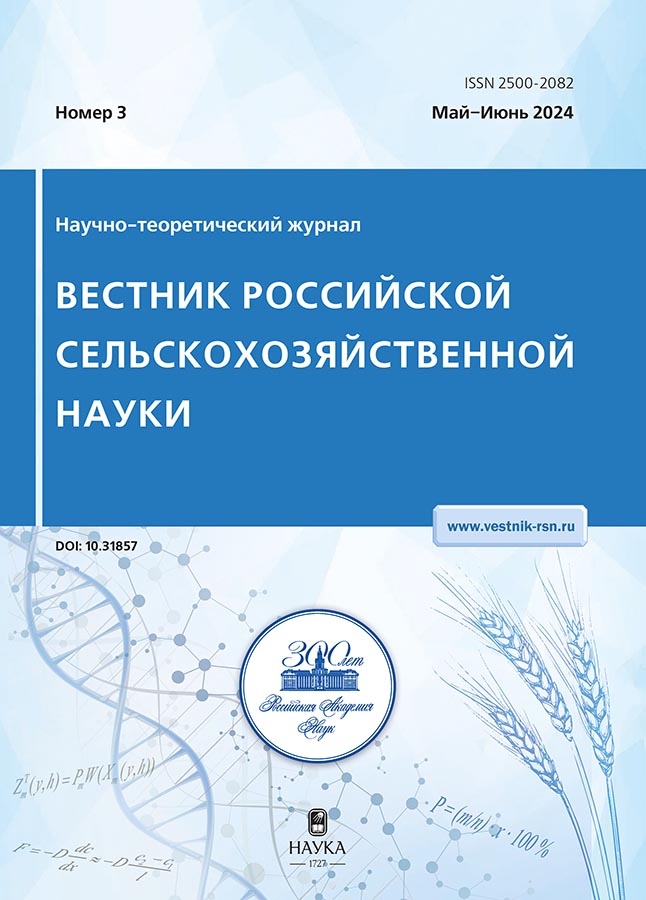The effects of cryopreservation and molecular hydrogen on the ultrastructure of bull spermatozoa
- Авторлар: Ivashchenko M.N.1,2, Deryuginа A.V.1, Latushko M.I.3, Belov A.A.1,2, Ignatiev P.S.3, Kovylin R.S.4, Erzutov A.I.2
-
Мекемелер:
- National Research Nizhny Novgorod State University named after N.I. Lobachevsky
- Nizhny Novgorod State Agrotechnological University
- Production Association “Ural Optical and Mechanical Plant named after E.S. Yalamov”
- Razuvaev G.A. Institute of Organometallic Chemistry of the Russian Academy of Sciences
- Шығарылым: № 3 (2024)
- Беттер: 81-84
- Бөлім: Zootechnics
- URL: https://vietnamjournal.ru/2500-2082/article/view/659331
- DOI: https://doi.org/10.31857/S2500208224030188
- EDN: https://elibrary.ru/yvyosp
- ID: 659331
Дәйексөз келтіру
Аннотация
The effect of molecular hydrogen during cryopreservation on the ultrastructures of bovine sperm cells has been studied. The study was performed on the sperm production of black-and-white Holstein bulls. The sperm was diluted with a sterile BioXcell medium (France). To study the effect of molecular hydrogen on the sperm cells of bulls, “BioXcell” diluted with hydrogen water was used. Native sperm diluted with the «BioXcell» diluent, sperm after deep freezing and sperm after deep freezing, pretreated with molecular hydrogen, were studied. The study of morphological parameters of spermatozoa after cryopreservation showed an increase in cells with an anomaly in the structure of the head, chromatin is insufficiently condensed, the content of spermatozoa with an altered position of the acrosome is increased, the ultrastructure of the axoneme is changed, irregular laying of mitochondria is noted. The use of molecular hydrogen as a cryoprotector contributed to an increase in the number of spermatozoa with intact heads having normal acrosomes, shape and chromatin of the nucleus. The results obtained indicate a positive effect of molecular hydrogen on morphological parameters of bovine sperm cells.
Негізгі сөздер
Толық мәтін
Авторлар туралы
M. Ivashchenko
National Research Nizhny Novgorod State University named after N.I. Lobachevsky; Nizhny Novgorod State Agrotechnological University
Хат алмасуға жауапты Автор.
Email: kafedra2577@mail.ru
PhD in Biological Sciences
Ресей, Nizhny Novgorod; Nizhny Novgorod
A. Deryuginа
National Research Nizhny Novgorod State University named after N.I. Lobachevsky
Email: kafedra2577@mail.ru
Grand PhD in Biological Sciences
Ресей, Nizhny NovgorodM. Latushko
Production Association “Ural Optical and Mechanical Plant named after E.S. Yalamov”
Email: kafedra2577@mail.ru
PhD in Engineering Sciences
Ресей, YekaterinburgA. Belov
National Research Nizhny Novgorod State University named after N.I. Lobachevsky; Nizhny Novgorod State Agrotechnological University
Email: kafedra2577@mail.ru
PhD in Biological Sciences
Ресей, Nizhny Novgorod; Nizhny NovgorodP. Ignatiev
Production Association “Ural Optical and Mechanical Plant named after E.S. Yalamov”
Email: kafedra2577@mail.ru
PhD in Physical and Mathematical Sciences
Ресей, YekaterinburgR. Kovylin
Razuvaev G.A. Institute of Organometallic Chemistry of the Russian Academy of Sciences
Email: kafedra2577@mail.ru
PhD in Chemical Sciences
Ресей, Nizhny NovgorodA. Erzutov
Nizhny Novgorod State Agrotechnological University
Email: kafedra2577@mail.ru
PhD Student
Ресей, Nizhny NovgorodӘдебиет тізімі
- Atroshchenko M.M., Kalashnikov V.V., Bragina E.E., Zajcev A.M. Sravnitel’noe izuchenie ul’trastruktury spermatozoidov v epididimal’noj, eyakulirovannoj i kriokonservirovannoj sperme zherebcov // Sel’skohozyajstvennaya biologiya. 2017. T. 52, № 2. S. 274–281. doi: 10.15389/agrobiology.2017.2.274rus
- Deryugina A.V., Ivashchenko M.N., Lodyanoj M.S. Ocenka rezistentnosti membran spermatozoidov bykov v processe dolgosrochnogo hraneniya // Estestvennye i tekhnicheskie nauki. 2022. T. 1 (164). S. 107–109.
- Nacional’naya tekhnologiya zamorazhivaniya i ispol’zovaniya spermy plemennyh bykov-proizvoditelej / pod red. A.I. Abilova, N.M. Reshetnikovoj. M.: 2008. 160 s.
- Nikitkina E.V., Shapiev I.Sh. Ispol’zovanie spermy bykov s nizkoj koncentraciej i aktivnost’yu spermatozoidov dlya kriokonservacii // Dostizheniya nauki i tekhniki APK 2010. № 7. S. 49–51.
- Rahmanin Yu.A., Egorova N.A., Mihajlova R.I. Molekulyarnyj vodorod: biologicheskoe dejstvie, vozmozhnosti primeneniya v zdravoohranenii (obzor) // Gigiena i sanitariya. 2019. T. 98. № 4. S. 359–365.
- Artamonov M.Y., Martusevich A.K., Pyatakovich F.A. et al. Molecular Hydrogen: From Molecular Effects to Stem Cells Management and Tissue Regeneration // Antioxidants. 2023. Vol. 12. № 3. P. 636. https://doi.org/10.3390/antiox12030636.
- Coetzee K., Ozgur K., Berkkanoglu M. et al. Reliable single sperm cryopreservation in Cell Sleepers for azoospermia management // Andrologia. 2016. № 48. P. 203–210. doi: 10.1111/and.12434.
- Endo Y., Fujii Y., Shintani K. et al. Simple vitrification for small numbers of human spermatozoa // Reprod Biomed Online. 2012. № 24. P. 301–307. doi: 10.1016/j.rbmo.2011.11.016.
- Evenson D., Darzynkiewicz Z., Melamed M. Relation of mammalian sperm heterogeneity to fertility // Science. 1980. № 210. P. 1131–1133.
- Moretti E., Sutera G., Collodel G. The importance of transmission electron microscopy analysis of spermatozoa: Diagnostic applications and basic research // Syst Biol Reprod Med. 2016. № 62. P. 171–83. doi: 10.3109/19396368.2016.1155242.
- Nijs M., Creemers E., Cox A. et al. Influence of freeze-thawing on hyaluronic acid binding of human spermatozoa // Reprod Biomed Online. 2009. № 19. P. 202–206. doi: 10.1016/S1472-6483(10)60073-9.
- Ohta S. Molecular hydrogen as a novel antioxidant: Overview of the advantages of hydrogen for medical applications // Methods in Enzymology. 2015. Vol. 555. P. 289–317.
- Ozkavukcu S., Erdemli E., Isik A. et al. Effects of cryopreservation on sperm parameters and ultrastructural morphology of human spermatozoa // J Assist Reprod Genet. 2008. Vol. 25. P. 403–411. doi: 10.1007/s10815-008-9232-3.
- Said T.M., Gaglani A., Agarwal A. Implication of apoptosis in sperm cryoinjury // Reprod Biomed Online. 2010. Vol. 21. P. 456–462. doi: 10.1016/j.rbmo.2010.05.011.
- Saleh R., Agarwal A. Oxidative stress and male infertility: from research bench to clinical practice // J Androl. 2002. Vol. 23. P. 737–752.
Қосымша файлдар









